On the face of it, Hebron seems like a typical middle-east town. Stone buildings shade narrow streets. A rainbow of vibrant colours jump out from every shop. Children play small-sided games of football on dusty pitches, which are covered in small stones, sticks, wire and pieces of rubber. The hum of prayer floats over ancient rooftops five times a day. Old men push rickety trolleys up ancient hills. And almost everyone stops to say ‘hello’.
“Hello,” they say. “Where are you from?”
“England,” I reply.
“Ah!” They respond. “You are welcome here!”
It’s a kind sentiment, which is echoed by almost everyone I meet. But it’s certainly not a sentiment that most locals would extend to the Zionist settlers who have made Hebron their home.
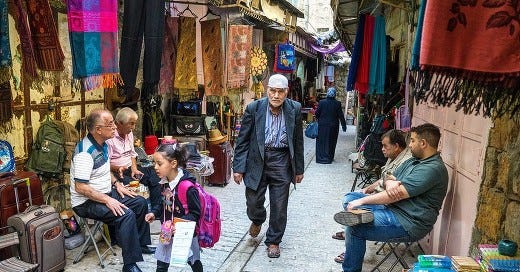
HISTORY
In 1968 a Rabbi moved into a military base on a hilltop overlooking Hebron. Once he had built his own home, he encouraged other Zionists to join him. They spread their caravans across the hillside, and then built permanent homes of their own. Before too long, similar settlements were popping up on the other hilltops. Then, in 1984, the settlers made a move on the old town itself.
A group of 45 Zionists, including women and children, moved into a building in the centre of old Hebron which they claimed was once owned by Jews. Over the months which followed those squatters added seven floors of flats, and encouraged more settlers to join them.
When a Jewish fundamentalist, Baruch Goldstein, shot dead 30 Palestinians at the Ibrahimi Mosque (located near the town-centre settlement), the Israelis shut down the main road through old Hebron, Shuhada Street, for “security reasons”.
The doors to every shop and house which lined that street were welded shut. Overnight, people found themselves homeless and unemployed. Some people were even trapped inside their own homes. They had to knock their walls down to escape!
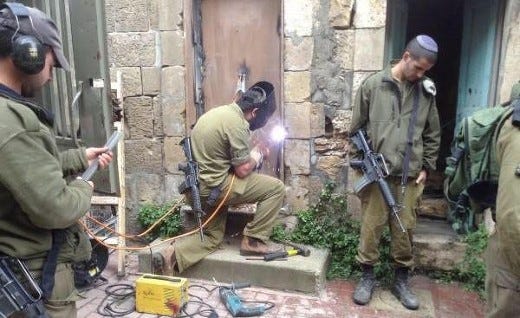
LIFE IN THE SHADOWS
Behind Shuhada Street, life continues as normal in the part of old Hebron which has not been occupied by settlers. Between closed market stalls, some traders still trade. Shoppers still shop. Stray cats still search for discarded scraps of food.
Nets stretch out overhead, covering the narrow alleys which snake between the old stone buildings. Rubbish, thrown from the settlers’ high-rise flats, sits atop those nets — causing them to sag. A white plastic chair hovers askew above shoppers heads. A broken bin liner leaks. Paper slowly skips along in the evening breeze.
I climb the stairs of the family home I am sharing, and enter the first-floor courtyard. A chicken runs by. Above my head I see two sentry-posts, both manned by armed teenage soldiers who are observing the town from their elevated position. I wave at one, who looks back at me with a stony-faced expression. He frowns, then disappears inside his cubicle, whilst I make my way into the living room.
A cup of tea is thrust into my hand as soon as I sit down. A cup of tea is always thrust into your hand as soon as you sit down in Palestine.
But the scene in front of me could be taking place in any country in the world. A small child stands on top of a small table, whilst his mother ties his laces. Two young boys play fight until one breaks down in tears. A third child plays with a homemade kite, made from a plastic bag and two sticks. The mother screams in her high-pitched tone, whilst her children ignore her. The father returns from a week spent working away, and gives some coconut pyramids to his family, whilst the TV plays on in the background.
RESISTANCE!
I awake to the news that there have been disturbances overnight, because an empty home was occupied by a group of settlers.
The family I am staying with seem frustrated. They tell me it’s about to snow, and that the Israelis will close the roads when it does. So I decide to leave Hebron whilst I have the chance, and visit Idna; a nearby village where elderly men drive donkeys, and young men drive cars; where sparrows occupy empty attics, and weeds occupy empty checkpoints.
Hidden behind the centre of this sleepy village is ‘Women in Hebron’; an embroidery collective which was set up to give local women jobs, independence, self-esteem and good company. The women seem happy here; measuring, stitching and cutting; joking with one another like children, slapping each other’s backs, laughing and giggling; making stuffed camels, purses, and pencils cases which read: ‘Women can do everything — Men can do something’.
Women in Hebron isn’t the only organization helping Palestinians back onto their feet. Another is the ‘Hebron Restoration Committee’ (HRC).
HRC renovates and repairs old buildings in the centre of Hebron so that evicted families can return to their ancestral homes. It’s more challenging than it may sound. Israeli soldiers have been known to arrest HRC’s workers, put up barriers, and stop their vehicles from reaching their destination. They’ve evicted families who’ve had their homes renovated. But that hasn’t stopped HRC. Using horses and donkeys to carry their supplies (and to circumnavigate the road-blocks), they have been able to bring over 6000 Palestinians back into old Hebron, much to the consternation of the settlers.
Then there’s ‘Youth Against Settlements, the group behind the ‘Open Shahuda Street’ protest due to snake through the streets of Hebron…
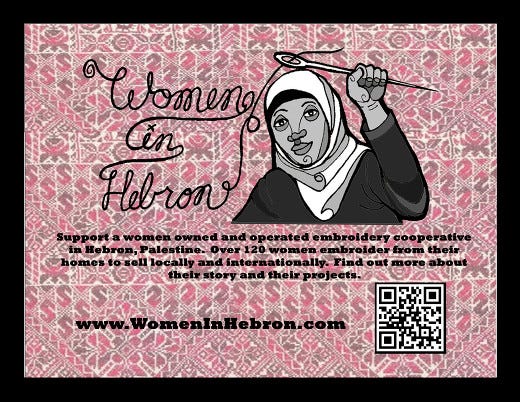
PROTEST
I walk through the snow to find the protest leader; a young man with Che Guevara charisma and the burden of his people on his shoulders. He seems in good spirits, despite having been put in jail the day before.
This is the calm before the storm.
Sunlight reflects off the snow, a dog sniffs another dog’s bottom, and a German charity worker (who is wearing a pair of long, chequered golfer’s socks and a red nose) starts to play his accordion.
The crowd trudges through the snow, picks up some more supporters outside a mosque, and continue down to a square located behind the original town centre settlement, on the open side of town.
A few protesters rattle the gates.
A few soldiers step forward.
“Bang!!!”
The sharp loud scream pierces every inch of my being. I feel shocked. I feel woozy, my stomach vibrates, my hands tingle, and I sway as I instinctively turn around to run.
I glance up at a man who is holding a metal object, and immediately think ‘gun’! I’m penned in, with gunmen on either side, and overcome by a pang of panic. Adrenaline flushes through my veins.
I take a step back. I focus. And I realize that the man I thought was holding a gun was just a boy holding a camera! The Israelis weren’t firing guns either — they were just throwing sound bombs.
“Bang!!!”
“Bang!!!”
“Bang!!!”
The sound is deafening, but it’s short and sharp; over almost as soon as it starts. So I soon become accustomed to the noise, as do the other protesters, who continue to chant:
“Free! Free! Free Palestine!”
“Open Shahuda Street!”
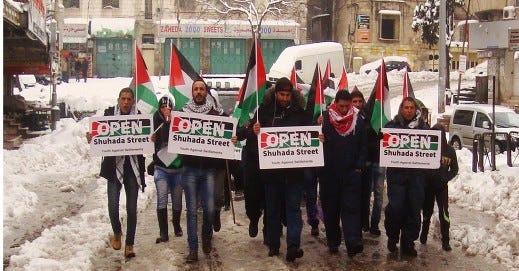
A snowball flies through the air. Another one follows. Then a third. They fly towards the soldiers, who point their guns at the crowd and throw more sound bombs our way.
A line of photographers stand on the opposite side of square. They look regimental; in perfect formation. The snow glistens, and the sun shines. The rest of the town seems still.
One soldier picks up a grenade which looks like a black metallic ostrich egg. It lands and sprays white tear- gas into the air. A cloud of gas floats across the street.
Usually, the protesters would throw such a canister back. The soldiers would respond with rubber bullets. People would get hurt.
But the snow plays its role well. A protester sprints towards the tear-gas grenade, dives through the air like a World War One soldier, and then buries the canister beneath the snow. The gas stops spraying.
Behind us some children are playing, oblivious (or perhaps merely accustomed) to the mayhem which is just a few metres away. They through snowballs at each other. One boy uses his dad’s walking stick as a baseball bat, and hits the snowballs his friend pitches to him. The accordion player plays on.
The soldiers send more tear-gas grenades our way. As if shot by a rocket launcher, they zoom through the air and send the crowd running. But the crowd stops, turns, and runs back into the mouth of the storm. Like waves on an ocean, the protesters run away, and then roll straight back again. Back and forth. Back and forth. Pulled by the gravity of duty.
A girl feints.
A man is carried away on a wooden trolley.
The protesters form circles away from the soldiers, and start to sing. Then they return for more.
The children mob a cameraman from ‘Palestine Today’. One shouts ‘Allah Akbar!’ The journalist has to re-start his report, whilst other children jostle for position behind him, hoping to get their faces onto the evening news.
Eventually the protesters retreat, and I return home to the warm comfort of the family living room. The TV broadcasts images of snowy scenery, set to terrible music. The father roasts chestnuts on his fire. The children play with my hat. And chickens run across the courtyard.
This blog was written to compliment Joss Sheldon’s second novel, ‘Occupied’, which was based on the occupations of Palestine, Kurdistan and Tibet.
The ebook version of Occupied is available from this website, here.
Physical copies are available from Amazon, Barnes & Noble, Waterstones, and all good online retailers…
Also in this blog series...

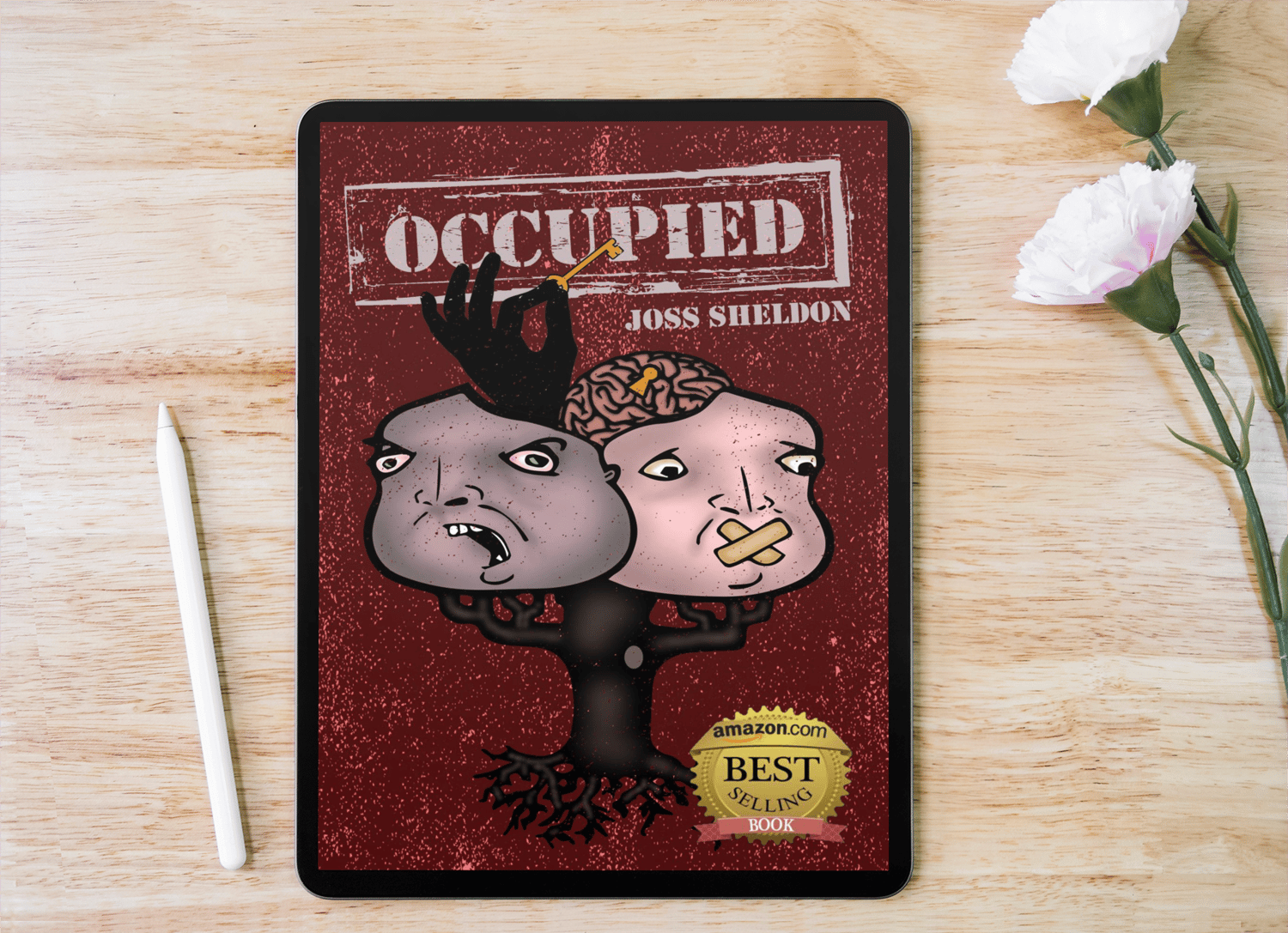
Comments ()